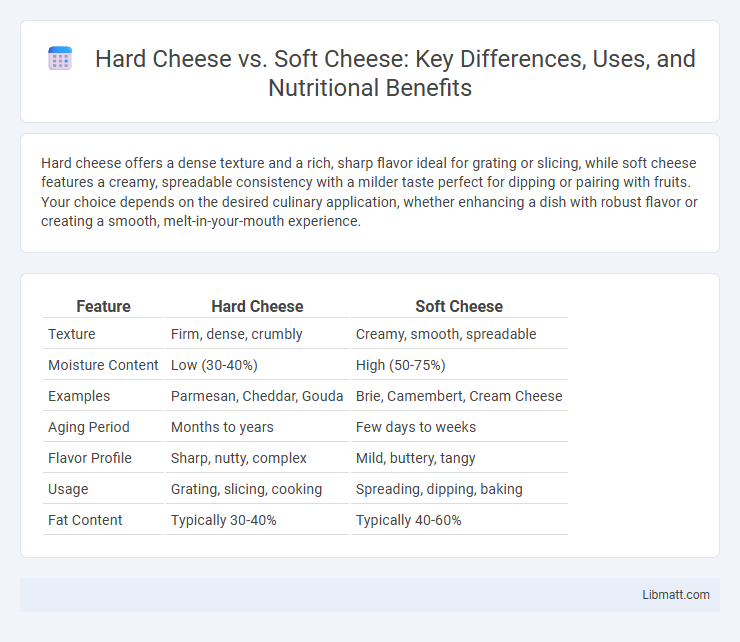Hard cheese offers a dense texture and a rich, sharp flavor ideal for grating or slicing, while soft cheese features a creamy, spreadable consistency with a milder taste perfect for dipping or pairing with fruits. Your choice depends on the desired culinary application, whether enhancing a dish with robust flavor or creating a smooth, melt-in-your-mouth experience.
Table of Comparison
| Feature | Hard Cheese | Soft Cheese |
|---|---|---|
| Texture | Firm, dense, crumbly | Creamy, smooth, spreadable |
| Moisture Content | Low (30-40%) | High (50-75%) |
| Examples | Parmesan, Cheddar, Gouda | Brie, Camembert, Cream Cheese |
| Aging Period | Months to years | Few days to weeks |
| Flavor Profile | Sharp, nutty, complex | Mild, buttery, tangy |
| Usage | Grating, slicing, cooking | Spreading, dipping, baking |
| Fat Content | Typically 30-40% | Typically 40-60% |
Introduction to Hard and Soft Cheeses
Hard cheeses like Parmesan and Cheddar undergo long aging processes that reduce moisture content, resulting in dense textures and robust flavors. Soft cheeses such as Brie and Camembert retain higher moisture, offering creamy, spreadable consistency and milder tastes. Understanding the differences in texture, aging, and flavor profiles helps you select the right cheese for cooking, pairing, or snacking.
Defining Hard Cheese
Hard cheese is characterized by its firm texture and low moisture content, resulting from extended aging processes that enhance flavor complexity and shelf life. Common examples include Parmesan, Cheddar, and Gouda, which develop granular textures and sharp, nutty tastes as they mature. This category contrasts with soft cheeses by offering greater durability and a more concentrated flavor profile ideal for grating or slicing.
Defining Soft Cheese
Soft cheese is characterized by its high moisture content, making it creamy, spreadable, and often delicate in texture. Varieties like Brie, Camembert, and cream cheese fall under this category, offering mild to tangy flavors that complement fresh herbs, fruits, and baked goods. Your culinary creations benefit from soft cheese's versatility, enhancing both savory dishes and desserts with its smooth consistency and rich taste.
Key Differences Between Hard and Soft Cheeses
Hard cheeses like Parmesan and Cheddar have low moisture content, resulting in a dense texture and longer shelf life, while soft cheeses such as Brie and Camembert contain higher moisture, making them creamier and more perishable. The aging process for hard cheeses often spans several months to years, enhancing their firmness and flavor intensity, whereas soft cheeses typically age for a shorter period, preserving their delicate taste and softness. Your choice between hard and soft cheese depends on desired texture, flavor profile, and culinary use.
Production Process Comparison
Hard cheese undergoes a longer aging process and lower moisture content, resulting in a firm texture and concentrated flavors, with production involving pressing curds to expel whey. Soft cheese retains higher moisture levels and involves minimal aging, yielding a creamy texture, often produced by gently ladling curds into molds without extensive pressing. The distinct production techniques impact texture, flavor profiles, and shelf life, with hard cheeses like Parmesan benefiting from months of curing, while soft cheeses like Brie require only a few weeks.
Flavor and Texture Profiles
Hard cheese offers a robust, sharp flavor with a dense, crumbly texture that intensifies with aging, such as Parmigiano-Reggiano or aged Cheddar. Soft cheese provides a creamy, mild, and often tangy taste paired with a smooth, spreadable texture, exemplified by Brie or Camembert. The distinct aging processes and moisture content directly influence the contrasting sensory experiences of hard versus soft cheeses.
Popular Types of Hard Cheeses
Popular types of hard cheeses include Parmesan, aged Cheddar, and Asiago, known for their firm texture and rich, complex flavors. These cheeses are often used for grating over dishes, adding depth to salads, pasta, and sauces. Your culinary creations can benefit from the distinctive sharpness and long shelf life that hard cheeses provide.
Popular Types of Soft Cheeses
Popular types of soft cheeses include Brie, Camembert, and Ricotta, each known for their creamy texture and rich flavor profiles. These cheeses are often enjoyed fresh and pair well with fruits, nuts, and wine, making them versatile in various culinary uses. Your cheese board can be elevated by incorporating these soft cheeses, offering a contrast to harder varieties like Cheddar or Parmesan.
Culinary Uses: Hard vs Soft Cheese
Hard cheese, such as Parmesan and Cheddar, is ideal for grating over pasta, salads, and soups, providing a sharp, concentrated flavor and firm texture that holds up well during cooking. Soft cheese varieties like Brie and Camembert are commonly used in spreads, dips, and baked dishes, offering creamy textures and mild to tangy flavors that melt smoothly. In culinary applications, the density and moisture content of hard cheese make it suitable for adding texture and intensity, while soft cheese excels in creating rich, smooth, and velvety dishes.
Nutritional Differences and Health Aspects
Hard cheese generally contains higher protein and calcium levels per serving compared to soft cheese, contributing to stronger bones and muscle maintenance. Soft cheese often has higher moisture content and lower fat concentration, making it easier to digest and suitable for those with cholesterol concerns. Both cheese types provide essential nutrients like vitamin B12 and phosphorus, but choosing between them depends on dietary goals such as caloric intake and fat consumption.
Hard Cheese vs Soft Cheese Infographic

 libmatt.com
libmatt.com